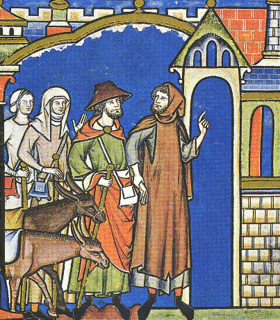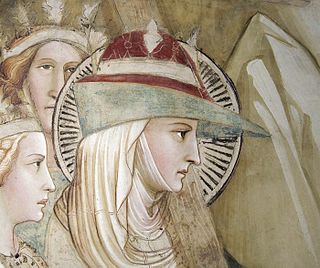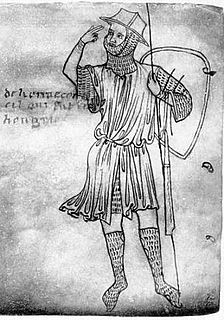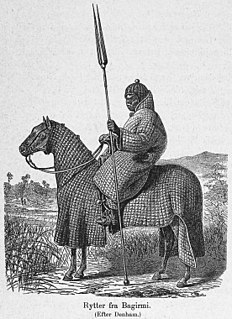 W
WCostume during the thirteenth century in Europe was very simple for both men and women, and quite uniform across the continent. Male and female clothing were relatively similar, and changed very slowly, if at all. Most clothing, especially outside the wealthier classes, remained little changed from three or four centuries earlier. The century saw great progress in the dyeing and working of wool, which was by far the most important material for outerwear. For the rich, colour and rare fabrics such as silk from the silkworm was very important. Blue was introduced and became very fashionable, being adopted by the Kings of France as their heraldic colour.
 W
WA bycocket or bycoket is a style of hat that was fashionable for both men and women in Western Europe from the 13th to the 16th century. It has a wide brim that is turned up in the back and pointed in the front like a bird's beak. In French, it is called a chapeau à bec due to this resemblance.
 W
WChausses are armour for the legs, usually made from mail. They could extend to the knee or cover the entire leg. Chausses were the standard type of metal leg armour in Europe from the 11th to the 14th century. Chausses offered flexible protection that was effective against slashing weapons. However, the wearer still felt the full force of crushing blows.
 W
WA gambeson is a padded defensive jacket, worn as armor separately, or combined with mail or plate armor. Gambesons were produced with a sewing technique called quilting. They were usually constructed of linen or wool; the stuffing varied, and could be for example scrap cloth or horse hair. During the 14th century, illustrations usually show buttons or laces up the front.
 W
WA gown, from the Saxon word, gunna, is a usually loose outer garment from knee- to full-length worn by men and women in Europe from the Early Middle Ages to the 17th century, and continuing today in certain professions; later, gown was applied to any full-length woman's garment consisting of a bodice and attached skirt. A long, loosely fitted gown called a Banyan was worn by men in the 18th century as an informal coat.
 W
WA herigaut is a gown-like garment worn in the thirteenth and early fourteenth centuries. Alternative spellings include herigald, heregaud, gerygoud and herigans. It was three-quarters to full length with hanging sleeves. Sometimes the sleeves were tucked at the top to increase fullness below. Although it was primarily a men's garment, women occasionally wore it as well. Along with the garnache, it is a variant of the garde-corps, and it is also related to the houppelande.
 W
WA surcoat or surcote is an outer garment that was commonly worn in the Middle Ages by both men and women in Western Europe. It can either refer to a coat worn over other clothes or the outermost garment itself. The name derives from French meaning "over the coat", a long, loose, often sleeveless coat reaching down to the feet.